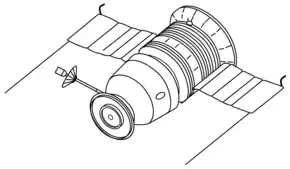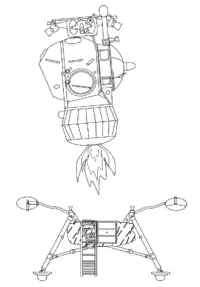Zond 7
Zond 7, a formal member of the Soviet Zond program and unmanned version of Soyuz 7K-L1 manned Moon-flyby spacecraft, the first truly successful test of L1, was launched towards the Moon on a Proton-K D rocket on August 7, 1969 on a mission of further studies of the Moon and circumlunar space, to obtain color photography of Earth and the Moon from varying distances, and to flight test the spacecraft systems. Earth photos were obtained on August 9, 1969. On August 11, 1969, the spacecraft flew past the Moon at a distance of 1984.6 km and conducted two picture taking sessions. On its way back from the moon the spacecraft tested its radio systems by transmitting recorded voices.[3] Zond 7 reentered Earth's atmosphere on August 14, 1969, and achieved a soft landing in a preset region south of Kustanai, Kazakhstan. On its trip the craft carried 4 turtles.[3] A human-like tissue-equivalent phantom for radiation measurements has been placed aboard. The phantom was equipped with 20 channels for radiation detectors (thermoluminescent glasses and nuclear photoemulsions) distributed along the whole body for measurement of doses in critical organs. The doses accumulated during the flight through the radiation belts and around the Moon were between 0.2 and 0.7 rad in different points at the depth of 3 g/cm2 from the body surface.[4]
 Zond 7 | |
| Names | Soyuz 7K-L1 s/n 11 |
|---|---|
| Mission type | Lunar flyby Spacecraft test |
| Operator | OKB-1 |
| COSPAR ID | 1969-067A |
| SATCAT no. | 04062 |
| Mission duration | 6 days, 18 hours, & 25 minutes[1] |
| Spacecraft properties | |
| Bus | Soyuz 7K-L1 |
| Manufacturer | OKB-1 |
| Launch mass | 5,979 kilograms (13,181 lb) |
| Start of mission | |
| Launch date | August 7, 1969, 23:48:06 UTC |
| Rocket | Proton-K D |
| Launch site | Baikonur 81/23 |
| End of mission | |
| Disposal | Soft landing and recovery |
| Recovered by | Soviet Union |
| Landing date | August 14, 1969 at 20:13 UTC |
| Landing site | 50 km south of Kustanai, Kazakhstan, USSR[2] |
| Flyby of Moon | |
| Closest approach | August 11, 1969 |
| Distance | 1,984.6 km (1,233.2 mi) |
Like other Zond circumlunar craft, Zond 7 used a relatively uncommon technique called skip reentry to shed velocity upon returning to Earth. Of all circumlunar Zond craft launches, Zond 7 would have been the first to make a safe flight for a crew had it been manned.
The return capsule is on display at the Orevo Facility of Bauman University in Dmitrov, Russia.
Notes
- This article was originally based on material from NASA (NSSDC) information on Zond 7
References
- https://www.nasa.gov/connect/ebooks/beyond_earth_detail.html
- "In Depth | Zond 7". NASA Solar System Exploration. Retrieved 2019-07-29.
- Harvey, Brian (2007). Soviet and Russian Lunar Exploration. Springer-Praxis. pp. 216–217. ISBN 0387218963.
- Smirennyi L. N., Litvinova E. G., Khortsev A. V. (1973). "Study of Spatial Distribution of Tissue Doses with the Aid of a Phantom-mannequin" (PDF). Proceedings of the Third International Congress of the International Radiation Protection Association; Washington, DC, September 9-14, 1973. Oak Ridge, Tennessee: U. S. ATOMIC ENERGY COMMISSION. pp. 648–653. CONF 730907 P1.CS1 maint: uses authors parameter (link)
